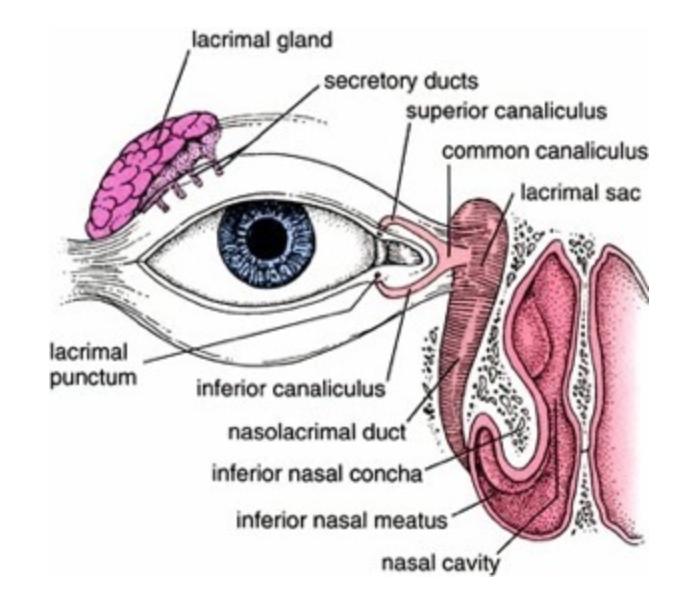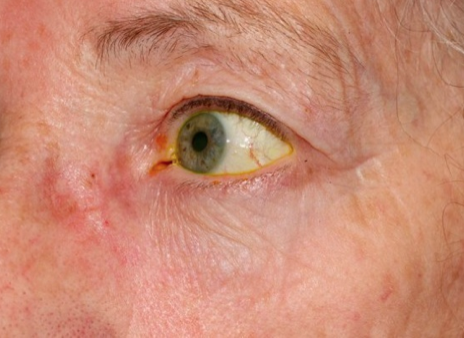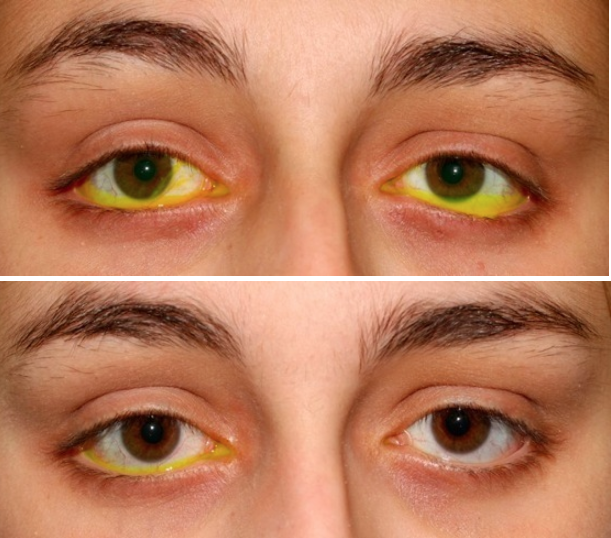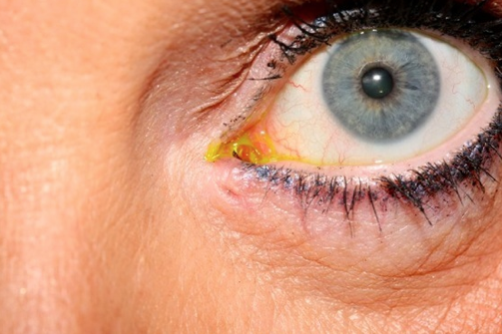Specialists who perform this surgery
Mr Austin McCormick
What is a blocked tear duct?
Tears are produced by the lacrimal gland, which is located in the upper outer part of the orbit, next to the eyeball.
Tears flow over the surface of the eye towards the nose.
The drainage of tears begins in the eyelid close to the nose. In both the upper and lower eyelid, where the eyelid touches the eyeball, there is a tiny opening called the punctum.
The punctum is the beginning of a tiny tube called the canaliculus. This tube runs from the punctum to the tear sac situated in the corner between the nose and the eyelids (where ‘sleep’ collects in the morning).
After tears have collected in the tear sac they flow down the tear duct into the nose.
The flow of tears can be blocked at any point in this drainage system. The commonest site of blockage is the tear duct, the last part of the drain.
When the tear drainage system is blocked, tears build up on the surface of the eye and overflow onto the cheek.
In some people the tear sac may also fill up with mucous (mucocele) or become infected (acute dacryocystitis).
What are the benefits of surgery?
Tear duct bypass surgery aims to reduce the symptoms of watery eyes.
If successful, tears should not run down the cheek, vision may improve a little and the lower eyelid may become less dry and scaly.
Recurrent discharge and conjunctivitis may also improve.
What are the alternatives to surgery?
There are no alternatives to surgery in bypassing the tear duct.
However some patients way up the risks and benefits of surgery and decide to put up with the watery eye, feeling that the risks of surgery are too great for them – it is an individual decision.
Having a blocked tear duct is not life threatening and does not damage the eye, so it is a reasonable option to decline surgery if you wish.
What will happen if I decide not to have surgery?
It is likely that you will continue to have a watery eye however this will not damage your eye in any way.
Some people with blocked tear ducts are at risk of infection of the tear sac (acute dacryocystitis). This presents as a painful red swelling near the inner corner of the eye (next to the nose) approximately the size of a grape. It requires antibiotic treatment and you should see a doctor the same day if it occurs.
What is Dacryocystorhinostomy - DCR?
Dacryocystorhinostomy (or ‘DCR’ for short) is an operation to bypass the tear duct.
A small amount of bone is removed in the lateral wall of the nose next to the eye.
A new passage way is created for tears to flow directly into the nose from the tear sac, bypassing the nasolacrimal duct.
At the end of the operation very fine tubes are placed within the new passageway to prevent scar tissue from closing it. These remain in place for 1-2 months in most cases. They are removed painlessly in clinic.
What is a blocked tear duct?
Tears are produced by the lacrimal gland, which is located in the upper outer part of the orbit, next to the eyeball.
Tears flow over the surface of the eye towards the nose.
The drainage of tears begins in the eyelid close to the nose. In both the upper and lower eyelid, where the eyelid touches the eyeball, there is a tiny opening called the punctum.
The punctum is the beginning of a tiny tube called the canaliculus. This tube runs from the punctum to the tear sac situated in the corner between the nose and the eyelids (where ‘sleep’ collects in the morning).
After tears have collected in the tear sac they flow down the tear duct into the nose.
The flow of tears can be blocked at any point in this drainage system. The commonest site of blockage is the tear duct, the last part of the drain.
When the tear drainage system is blocked, tears build up on the surface of the eye and overflow onto the cheek.
In some people the tear sac may also fill up with mucous (mucocele) or become infected (acute dacryocystitis).
What are the benefits of surgery?
Tear duct bypass surgery aims to reduce the symptoms of watery eyes.
If successful, tears should not run down the cheek, vision may improve a little and the lower eyelid may become less dry and scaly.
Recurrent discharge and conjunctivitis may also improve.
What are the alternatives to surgery?
There are no alternatives to surgery in bypassing the tear duct.
However some patients way up the risks and benefits of surgery and decide to put up with the watery eye, feeling that the risks of surgery are too great for them – it is an individual decision.
Having a blocked tear duct is not life threatening and does not damage the eye, so it is a reasonable option to decline surgery if you wish.
What will happen if I decide not to have surgery?
It is likely that you will continue to have a watery eye however this will not damage your eye in any way.
Some people with blocked tear ducts are at risk of infection of the tear sac (acute dacryocystitis). This presents as a painful red swelling near the inner corner of the eye (next to the nose) approximately the size of a grape. It requires antibiotic treatment and you should see a doctor the same day if it occurs.
What is Dacryocystorhinostomy - DCR?
Dacryocystorhinostomy (or ‘DCR’ for short) is an operation to bypass the tear duct.
A small amount of bone is removed in the lateral wall of the nose next to the eye.
A new passage way is created for tears to flow directly into the nose from the tear sac, bypassing the nasolacrimal duct.
At the end of the operation very fine tubes are placed within the new passageway to prevent scar tissue from closing it. These remain in place for 1-2 months in most cases. They are removed painlessly in clinic.
There are two ways to carry out this surgery: External and Endonasal
External DCR
A 1 cm vertical skin incision is made on the side of the nose in the same area that the footplates of glasses sit.
Bone is removed using hand held instruments.
After the new passageway has been created for tears to flow into the nose, lacrimal stents are placed in this passageway to prevent closure of it. The skin is closed with stitches. These skin stitches will be removed in clinic 7 – 10 days later.
This operation is the more traditional technique and we know more about its long-term success than any other operation. Although the scar formed is usually very hard to see, in rare cases it may be prominent. In some patients the strength of blink of the eyelids may be temporarily reduced after this operation.
The success rate of this operation is approximately 95%.
This operation may be carried out under general anaesthesia or local anaesthesia plus intravenous sedation
Endonasal DCR
The operation is carried out without a skin incision.
Using a tiny endoscopic camera, carefully placed inside the nostril, the operation is performed using instruments inside the nose. This includes the same hand held instruments as in external DCR, but also a drill to remove bone.
The rest of the procedure is very similar to external DCR.
The postoperative care is slightly different in that we recommend nasal douching postoperatively. This is carried out using ready-made nasal sprays.
The main advantage of this procedure is that it avoids a skin incision. This is not only beneficial from a cosmetic point of view but it reduces the small risk of bleeding or infection associated with a skin wound. In addition the strength of blink is not reduced after surgery.
Because the operation is carried out inside the nose there needs to be adequate space for the surgeon to see what he/she is doing. The central dividing tissue between each side of the nose is called the septum. It is very rarely completely straight but in some it is significantly deviated to one side. It may be necessary to carry out a septoplasty to enable an endonasal DCR to be completed. In this procedure part of the cartilage in the septum is carefully removed to create more space. This is a relatively straightforward procedure. It carries with it the rare risks of a septal perforation or altered contour of the nose.
This operation is usually carried out under general anaesthesia.
Lester Jones Tube endonasal DCR
If the canaliculus is blocked the above operations will not work. In this situation the natural tear drainage system needs to be completely bypassed.
This is done using a Lester Jones Tube. This operation is not an alternative to external / endonasal DCR, it is the only procedure that will work in these cases.
The L J Tube is made from Pyrex glass and is approximately 1 – 1.5cm long and 3-4mm in diameter. The top part of it sits in the corner of the eye near to the nose whilst the rest of the tube passes diagonally into the cavity of the nose.
Tears, which naturally collect in the inner corner of the eye, may then drain down the tube into the nose.
The operation is carried out using the endonasal technique to make a passageway into the nose for the tube.
The same benefits and risks as for endonasal DCR apply to this operation.
Because the tube is man made it is prone to blocking and so we ask people to instill artificial tear drops every day to keep the tube clear. If it blocks it will need surgically replacing.
Overall 1/3rd of people require 1 operation, a further 1/3rd need 2 operations and a further 1/3rd need multiple surgeries in their lifetime in order to keep this system draining tears.
If you do not like the tube this operation is reversible, in that simply by removing the tube you are no different to prior to surgery.
This operation is carried out under general anaesthesia.
What are the risks and possible complications of surgery?
Infection might present as increased swelling and redness of the skin. There might also be yellow discharge from the wound. It is treated with antibiotics.
Bleeding may present as a nose bleed, fresh blood oozing from the site of surgery or a lump appearing near the wound after the operation. Simple pressure on a skin wound is usually enough to control minor bleeding. A nose bleed is usually stopped by sitting down, staying calm, pinching the bottom of your nose and placing an ice pack across the bony bridge of the nose.
A collection of blood (haematoma) under the skin may be massaged and will usually settle without further surgery. A haematoma collecting in the orbit, behind the eye, may compress the nerve of vision and threaten eyesight. It is extremely rare for this to occur. It presents as pain, loss of vision and a bulging forwards of the eyeball. It is an emergency and as such is initially treated in an accident and emergency department where an oculoplastic surgeon should be contacted urgently.
Meningitis. Part of the operation involves the removal of a small piece of bone from the wall of the nose. This bone is in direct contact with the base of the skull. It is theoretically possible for bone to be removed too high up, into the base of the skull. This can cause a leak of brain fluid (cerebrospinal fluid – CSF) and is itself a risk factor for meningitis. This is potentially serious but extremely rare and has never occurred in one of Mr McCormick’s patients.
Scar. Whenever the skin is incised a scar may form. Every attempt is made by the surgeon to minimise and hide scars but sometimes they can be visible.
Loss of sight. The site of surgery is in close proximity to the eyeball. Although extremely unlikely, whenever surgery is carried out close to the eye there is a potential risk of damage to the eye and therefore to eyesight.
Stent problems. Part of the operation involves the insertion of lacrimal stents. These are very fine plastic tubes that pass from the punctum into the nose, following the new pathway for tears to flow. They may be visible to you if you look closely in the mirror in the corner of the eye close to the nose. All that should be visible is a short piece of tubing running from the upper lid down into the lower lid. Sometimes the tubing can become more prominent and appear over the eyeball. If this happens do not pull the tubing. Place some ointment on the eye and try to gently massage the loop of tubing towards the nose. The other end of the tubing is in the nose. Again if you find this, don’t pull it rather push it back into the nostril.
What type of anaesthesia will I have?
Two types of anaesthesia are used for these procedures: local anaesthetic with intravenous sedation; general anaesthesia.
You will choose one of them based on the advice of your surgeon.
Local anaesthesia with Intravenous Sedation means that you are breathing for yourself and don’t have a breathing tube inserted but you are very relaxed and sleepy and often don’t remember the operation or the local anaesthetic injection. Only External DCR.
General anaesthetic means you are completely asleep with a breathing tube inserted. External or Endonasal DCR
What are the risks of anaesthesia?
You will have the opportunity to discuss the risks of anaesthesia with your surgeon and anaesthetist prior to surgery. It is worth noting that modern anaesthesia in all its forms is extremely safe.
Local anaesthetic may cause bruising, bleeding and swelling. There is a theoretical risk of the needle penetrating the eye and causing loss of vision.
Intravenous sedation should be carried out by an anaesthetist in a controlled environment. In this way it is very safe. There is a risk of loss of airway, which theoretically could lead to brain injury or death.
General anaesthetic has an extremely low risk of heart attack, stroke and death. The risk very much depends upon your general health and will be assessed prior to surgery.
Anaesthetic risks can usually be greatly reduced by thorough pre operative assessment, which you will receive.
What will happen before surgery?
Before the operation you will be seen in the clinic by Mr. McCormick.
Mr McCormick will ask you about your problem. He/she will also ask about other medical problems you have, medications you take and any allergies (bring a list or the tablets themselves with you).
Mr McCormick will examine your eyes and will determine if the tear duct is blocked by very gently flushing it with salt water.
If you are to proceed with surgery the operation will be discussed in detail. This will include any risks or possible complications of the operation and the method of anaesthesia.
You will be asked to read and sign a consent form after having the opportunity to ask any questions.
You will also see a preoperative assessment nurse. He/She will carry out blood tests and an ECG (heart tracing) if required. He/She will also advise you if you need to starve before the operation.
What should I do about my medication?
Mr McCormick will want to know all the medication that you take and about any allergies you have.
In some cases you may be asked to stop or reduce the dose of blood thinning tablets like: warfarin, aspirin, clopidogrel (plavix), dipyridamole (persantin). This decision is made on an individual basis and you should only do so if it is safe and you have been instructed by your GP, surgeon or anaesthetist. This will be discussed with you before surgery.
Other medication should be taken as usual. You should avoid herbal remedies for 2 weeks prior to surgery as some of these may cause increased bleeding at the time of surgery.
What should I expect after surgery?
After surgery you may experience some pain due to the removal of bone. Simple paracetamol is usually enough to control this.
Your nose will feel blocked for up to 6 weeks after the operation although it often clears long before this.
The eyelids may be a little bruised or swollen, which may take up to 2 weeks to settle.
The eye may still water until the stents (tubes) are removed up to 3 months later.
Post operative Instructions
All DCR
No hot drinks or strenuous activity for 48 hours
Pad overnight
Sleep at 30 degrees propped up 48 hours
No nose blowing until stents removed , no holding nose if sneezing, place 2 fingers over the corner of the eye near the nose
You may go home the same day if not too distant from the hospital and if you have someone staying with you overnight, If not you may stay in hospital for the first night.
If staying overnight - nasal pack tray at bedside for epistaxis
Epistaxis Patient Information Sheet to be given to patient. Follow up clinic 1 week
Specific external DCR instructions
As for ‘All DCR’ above plus
Apply chloramphenicol ointment to the skin wound 4 times a day for 2 weeks
Specific endonasal DCR instructions
As for ‘All DCR’ above plus......
Swab taped underneath nostril overnight – remove in the morning.
Sterimar or similar saline nasal spray 4 times a day to the operated nostril for 4 weeks
Betensol 4 times a day to affected nostril for 4 weeks
Otrivine twice a day to affected nostril for 2 weeks
Specific Lester Jones Tube DCR instructions
As for ‘All DCR’ above plus ‘Endonasal DCR’ plus
Hypromellose eye drops 4 times a day indefinitely. Hold nose and suck the drops down the tube.
If the tube becomes slightly prominent, clean your hands and gently push it back towards the eye. Do not pull it out all together.

.png)
.png)
Above Top is the anatomy before surgery. Compare this with the middle diagram where bone has been removed. The superior and inferior canaliculus now open directly into the nasal space - the nasolacrimal duct has been bypassed.
At the end of the procedure a lacrimal stent is placed (Bottom diagram). This is a very fine solid piece of plastic or silicone. It is passed down each canaliculus and tied in the nasal space. It is used to prevent scar tissue closing the passage way created by surgery. It is not a drain. After 6 weeks in most cases it is removed painlessly in clinic.

Above: The appearance 6 weeks following External Dacryocystorhinostomy. the lacrimal stent can just be made out running from the upper canaliculus to the lower canaliculus in the corner of the eye. The incision on the side of the nose has healed well and is hardly visible.

Above Top - Before left Endonasal Dacryocystorhinostomy surgery. The tear film has been stained with yellow fluorescein dye. It is markedly raised demonstrating the lack of tear drainage. Above Bottom - Following surgery to the left. The tear film is normal and the lacrimal stent can just be seen in the corner of the eye running from the upper to lower canaliculus.

Above: A Lester Jones Tube has been placed after an Endonasal Dacryocystorhinostomy. The top of the glass tube can be seen in the corner of the eye. The tears have been stained yellow with fluorescein dye